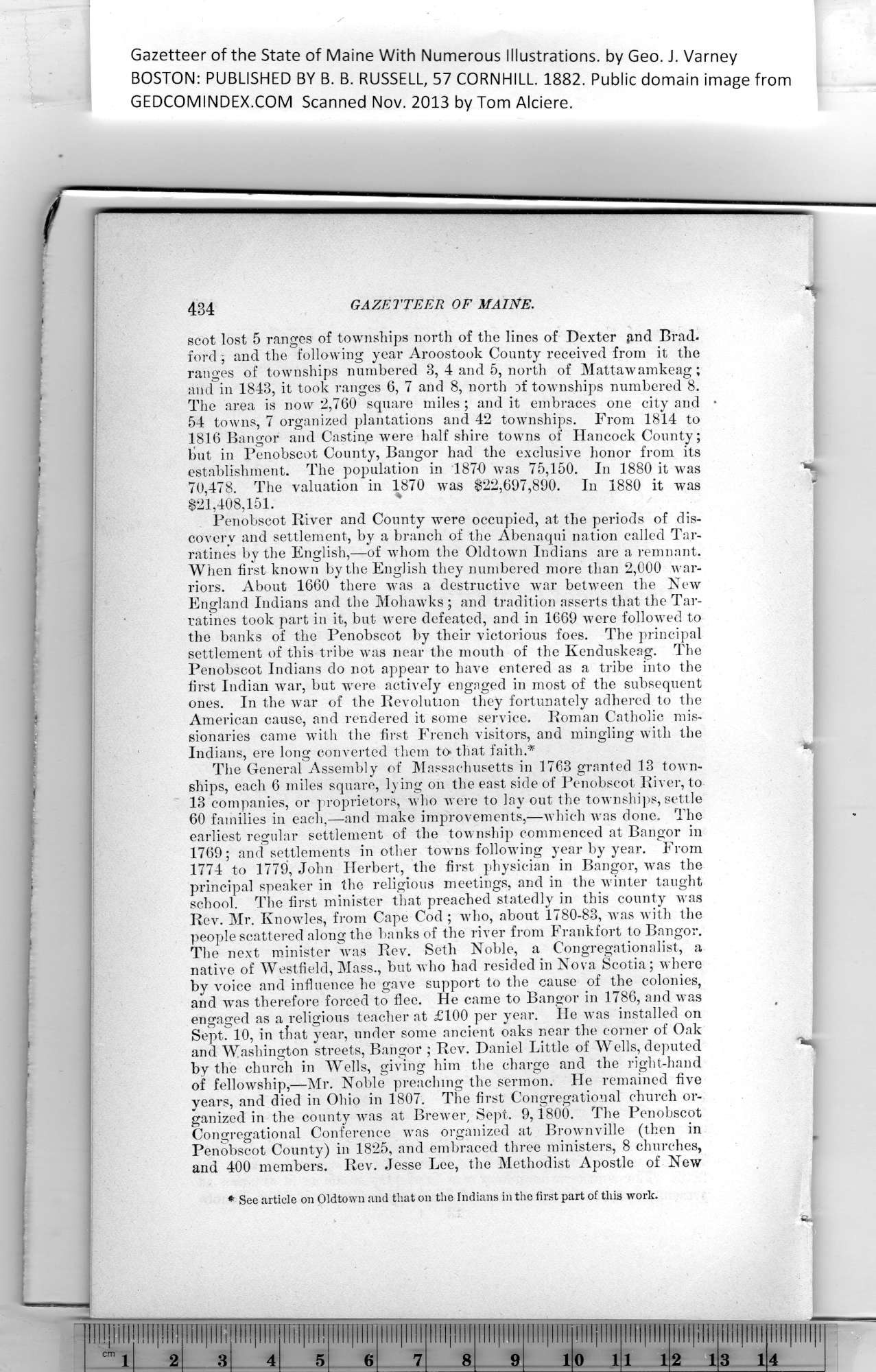|
Gazetteer of the State of Maine With Numerous Illustrations, by Geo. J. Varney
BOSTON: PUBLISHED BY B. B. RUSSELL, 57 CORNHILL. 1882. Public domain image from
434 GAZETTEER OF MAINE.
scot lost 5 ranges of townships north of the lines of Dexter and Brad,
ford ; and the following year Aroostook County received from it the
ranges of townships numbered 3, 4 and 5, north of Mattawamkeag;
and in 1843, it took ranges 6, 7 and 8, north of townships numbered 8.
The area is now 2,760 square miles ; and it embraces one city and
54 towns, 7 organized plantations and 42 townships. From 1814 to
1816 Bangor and Castine were half shire towns of Hancock County;
but in Penobscot County, Bangor had the exclusive honor from its
establishment. The population in 1870 was 75,150. In 1880 it was
70,478. The valuation in 1870 was $22,697,890. In 1880 it was
$21,408,151. 1
Penobscot River and County were occupied, at the periods of dis-
covery and settlement, by a branch of the Abenaqui nation called Tar-
ratines by the English,—of whom the Oldtown Indians are a remnant.
When first known by the English they numbered more than 2,000 war-
riors. About 1660 there was a destructive war between the New
England Indians and the Mohawks; and tradition asserts that the Tar-
ratines took part in it, but were defeated, and in 1669 were followed to
the banks of the Penobscot by their victorious foes. The principal
settlement of this tribe was near the mouth of the Kenduskeag. The
Penobscot Indians do not appear to have entered as a tribe into the
first Indian war, but were actively engaged in most of the subsequent
ones. In the war of the Revolution they fortunately adhered to the
American cause, and rendered it some service. Roman Catholic mis-
sionaries came with the first French visitors, and mingling with the
Indians, ere long commrted them to- that faith.*
The General Assembly of Massachusetts in 1763 granted 13 town-
ships, each 6 miles square, lying on the east side of Penobscot River, to
13 companies, or proprietors, who were to lay out the townships, settle
60 families in each,—and make improvements,—which was done. The
earliest regular settlement of the township commenced at Bangor in
1769; and settlements in other towns following year by year. From
1774 to 1779, John Herbert, the first physician in Bangor, was the
principal speaker in the religious meetings, and in the winter taught
school. The first minister that preached statedly in this county was
Rev. Mr. Knowles, from Cape Cod ; who, about 1780-83, was with the
people scattered along the hanks of the river from Frankfort to Bangor.
The next minister was Rev. Seth Noble, a Congregationalist, a
native of Westfield, Mass., but who had resided in Nova Scotia; where
by voice and influence he gave support to the cause of the colonies,
and was therefore forced to flee. He came to Bangor in 1786, and was
engaged as a religious teacher at £100 per year. He was installed on
Sept. 10, in that year, under some ancient oaks near the corner of Oak
and Washington streets, Bangor ; Rev. Daniel Little of Wells, deputed
by the church in Wells, giving him the charge and the right-hand
of fellowship,—Mr. Noble preaching the sermon. He remained five
years, and died in Ohio in 1807. The first Congregational church or-
ganized in the county was at Brewer, Sept. 9,1800. The Penobscot
Congregational Conference was organized at Brownville (then in
Penobscot County) in 1825, and embraced three ministers, 8 churches,
and 400 members. Rev. Jesse Lee, the Methodist Apostle of New
1
See article on Oldtown and that on the Indians in the first part of this work.
PREVIOUS PAGE ... NEXT PAGE
This page was written in HTML using a program written in Python 3.2
|
